Classifying sedimentary rocks involves understanding their formation processes, composition, and texture, which is where rockscapes.net comes in handy, offering detailed insights. This classification is vital for various applications, from landscaping with appealing rock formations to understanding geological history and sedimentary environments. Delve into the fascinating realm of sedimentary rock classification, exploring detrital rocks, chemical rocks, and organic rocks and their unique characteristics.
Table of Contents
- Understanding Sedimentary Rocks
- What Are The Three Main Types Of Sedimentary Rocks?
- Clastic Sedimentary Rocks: A Detailed Look
- Chemical Sedimentary Rocks: Formation and Types
- Organic Sedimentary Rocks: The Role of Living Organisms
- Sedimentary Rock Textures: Grain Size, Sorting, and Rounding
- Sedimentary Structures: Clues to Past Environments
- Classifying Sedimentary Rocks: A Step-by-Step Guide
- Applications of Sedimentary Rock Classification
- The Importance of Sedimentary Rocks in Landscaping
- FAQ: Understanding Sedimentary Rock Classification
1. Understanding Sedimentary Rocks
Sedimentary rocks are formed from the accumulation and cementation of sediments, which can include mineral grains, rock fragments, and organic material. According to the U.S. Geological Survey, these rocks cover about 75% of the Earth’s land surface and provide valuable information about Earth’s history, past environments, and the processes that shape our planet. Sedimentary rocks are essential for understanding geological history, identifying potential resources, and creating stunning landscapes.
Sedimentary rocks are formed through a fascinating process that involves several key steps:
-
Weathering and Erosion: The journey begins with the breakdown of pre-existing rocks through weathering, which can be physical (mechanical) or chemical. Physical weathering involves the disintegration of rocks into smaller fragments without changing their chemical composition. Examples include frost wedging, where water freezes in cracks and expands, and abrasion, where rocks are worn down by friction. Chemical weathering, on the other hand, alters the chemical composition of rocks through processes like oxidation, hydrolysis, and dissolution. Erosion then transports these weathered materials away from their source.
-
Transportation: Once the sediments are weathered and eroded, they must be transported to a new location. This can happen through various agents, including water, wind, ice, and gravity. Water is the most common agent of transportation, carrying sediments in rivers, streams, and ocean currents. Wind can transport fine-grained sediments like sand and dust over long distances. Glaciers are powerful agents of transportation, carrying massive amounts of sediment as they move. Gravity can also transport sediments through landslides and debris flows.
-
Deposition: Eventually, the transporting agent loses energy, and the sediments are deposited. This typically occurs in areas like riverbeds, deltas, lakes, and ocean basins. The characteristics of the depositional environment, such as water depth, current velocity, and sediment supply, play a crucial role in determining the type of sedimentary rock that will eventually form.
-
Lithification: After deposition, the sediments undergo lithification, a process that transforms them into solid rock. Lithification involves two main steps: compaction and cementation. Compaction occurs as the weight of overlying sediments compresses the lower layers, reducing the pore space between grains. Cementation involves the precipitation of minerals from groundwater within the pore spaces, binding the sediment grains together. Common cementing agents include calcite, silica, and iron oxides.
Sedimentary rocks are not just products of these processes; they are also archives of Earth’s history, offering insights into past environments, climates, and life forms. The characteristics of sedimentary rocks, such as their composition, texture, and sedimentary structures, provide clues about the conditions under which they were formed.
2. What Are The Three Main Types Of Sedimentary Rocks?
Sedimentary rocks are primarily classified into three main types: clastic, chemical, and organic. These categories are based on the origin and composition of the sediments that form the rock. Knowing these distinctions is critical for appreciating the diversity and significance of sedimentary rocks in both geological studies and practical applications such as landscaping.
Clastic Sedimentary Rocks
Clastic sedimentary rocks are formed from the accumulation and cementation of mineral grains, rock fragments, and pre-existing rock pieces. These rocks are often referred to as detrital sedimentary rocks because the sediments are derived from the mechanical weathering and erosion of other rocks. They’re formed from the accumulation of broken bits of rocks and minerals.
Common examples include:
-
Sandstone: Primarily composed of sand-sized grains of quartz, feldspar, and lithic fragments.
-
Shale: Made up of fine-grained clay minerals.
-
Conglomerate: Contains rounded gravel-sized clasts cemented together.
-
Breccia: Similar to conglomerate but with angular clasts.
Chemical Sedimentary Rocks
Chemical sedimentary rocks form through the precipitation of minerals from solutions. This can occur either inorganically or through biological activity.
Key examples include:
-
Limestone: Mainly composed of calcium carbonate ((CaCO_3)), often formed from the accumulation of marine organisms’ shells and skeletons.
-
Rock Salt: Composed of halite (sodium chloride, (NaCl)), formed by the evaporation of saline water.
-
Chert: Made of microcrystalline quartz, often formed from the accumulation of silica-rich organisms’ remains.
Organic Sedimentary Rocks
Organic sedimentary rocks are formed from the accumulation and lithification of organic matter, such as plant and animal remains.
Prominent examples are:
-
Coal: Formed from the accumulation and compaction of plant material in swamps and bogs.
-
Fossiliferous Limestone: Contains a high concentration of fossils and organic material.
Each type of sedimentary rock offers unique insights into Earth’s history and has different uses in various industries. Understanding these classifications helps geologists, landscapers, and homeowners alike appreciate the versatility and significance of sedimentary rocks.
3. Clastic Sedimentary Rocks: A Detailed Look
Clastic sedimentary rocks are a significant group, making up a large portion of the sedimentary rocks found on Earth. These rocks are formed from the accumulation and cementation of clasts, which are fragments of pre-existing rocks and minerals. The processes involved in their formation—weathering, erosion, transportation, deposition, and lithification—leave distinct marks on their characteristics, making them a rich source of geological information.
Formation of Clastic Sedimentary Rocks
The formation of clastic sedimentary rocks involves several key stages:
- Weathering: The breakdown of rocks into smaller fragments.
- Erosion: The removal of these fragments from their source.
- Transportation: The movement of the sediments by wind, water, or ice.
- Deposition: The settling of the sediments in a new location.
- Lithification: The compaction and cementation of the sediments into solid rock.
Types of Clastic Sedimentary Rocks
-
Conglomerate: Characterized by rounded gravel-sized clasts, indicating significant transportation and abrasion. Conglomerates often form in high-energy environments like riverbeds, where the clasts are rounded by constant tumbling.
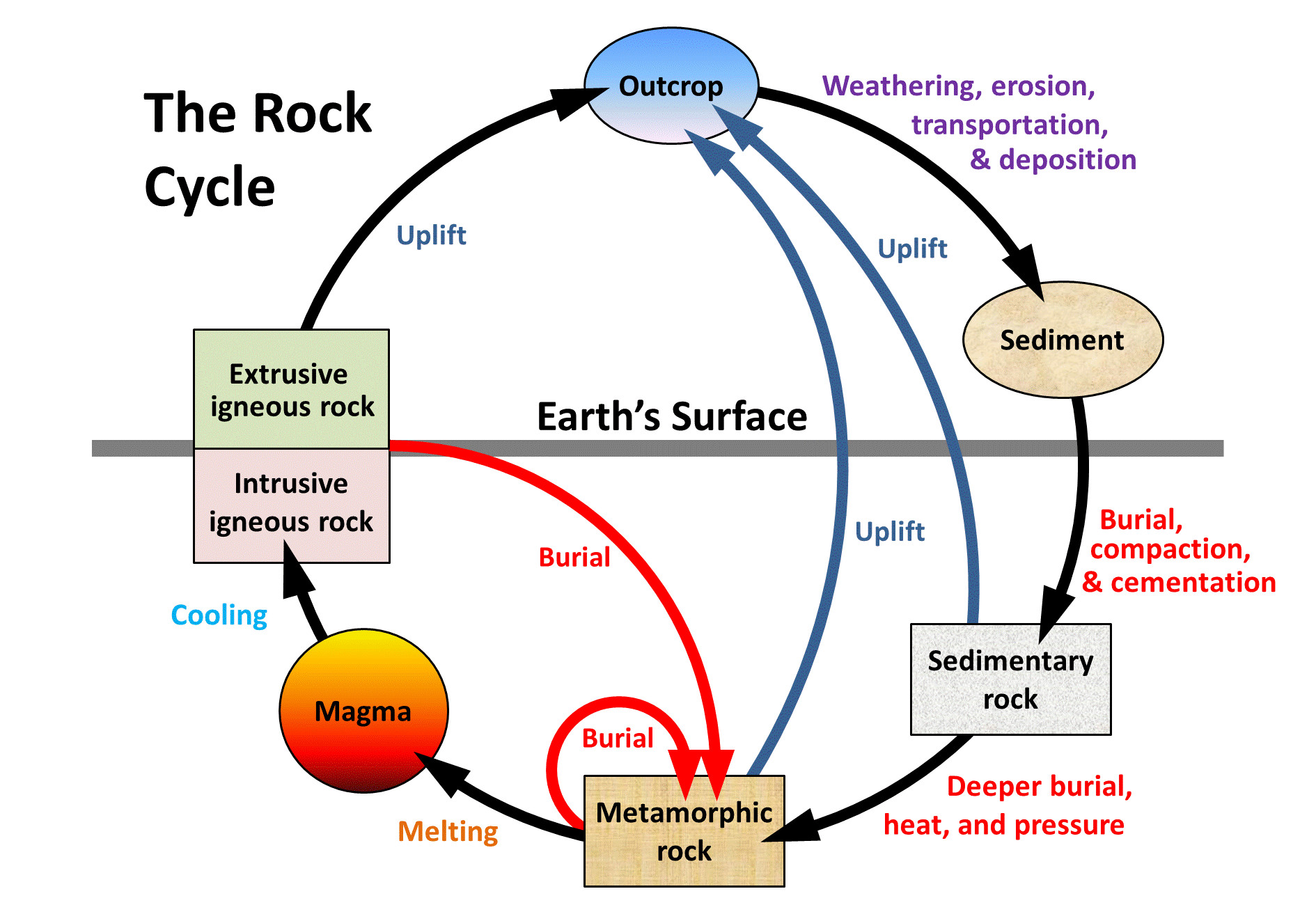 Conglomerate rock featuring various rounded pebbles of different colors embedded in a matrix
Conglomerate rock featuring various rounded pebbles of different colors embedded in a matrix -
Breccia: Similar to conglomerate but composed of angular clasts. The angularity suggests minimal transportation and abrasion, indicating that the clasts were deposited close to their source. Breccias are commonly found in environments like alluvial fans and fault zones.
-
Sandstone: Primarily composed of sand-sized grains, typically quartz, feldspar, and lithic fragments. Sandstones can be further classified based on their mineral composition, such as quartz arenite (mostly quartz), arkose (significant feldspar content), and litharenite (abundant rock fragments). Sandstones are formed in a variety of environments, including beaches, dunes, and river channels.
-
Shale: The most abundant clastic sedimentary rock, composed of very fine-grained clay minerals. Shales are formed in low-energy environments like lake bottoms and deep marine settings, where fine particles can settle out of suspension. The layered structure of shale makes it prone to weathering and erosion.
Characteristics of Clastic Sedimentary Rocks
- Grain Size: Clastic rocks are classified based on the size of their clasts, ranging from gravel to clay.
- Sorting: Refers to the uniformity of grain sizes. Well-sorted rocks have grains of similar size, while poorly sorted rocks have a wide range of grain sizes.
- Rounding: Describes the shape of the clasts. Rounded clasts indicate extensive transportation and abrasion, while angular clasts suggest minimal transport.
- Composition: The mineral and rock fragments that make up the clasts. The composition of clastic rocks reflects the source rocks from which the sediments were derived.
Clastic sedimentary rocks are valuable indicators of past environments and geological processes. They are also economically important, serving as reservoirs for groundwater and petroleum, and as building materials in the landscaping industry.
4. Chemical Sedimentary Rocks: Formation and Types
Chemical sedimentary rocks are formed through the precipitation of minerals from solutions. This process can occur either inorganically, due to changes in temperature, pressure, or chemical composition, or organically, through the actions of living organisms. These rocks provide critical insights into the chemical conditions of past environments.
Formation of Chemical Sedimentary Rocks
The formation of chemical sedimentary rocks typically involves the following steps:
- Dissolution: Minerals are dissolved in water, creating a solution rich in dissolved ions.
- Transportation: The solution is transported to a new location.
- Precipitation: The dissolved minerals precipitate out of the solution, forming solid mineral grains.
- Accumulation: The mineral grains accumulate over time, forming a sedimentary rock.
Types of Chemical Sedimentary Rocks
-
Limestone: Primarily composed of calcium carbonate ((CaCO_3)). It can form inorganically through the precipitation of calcium carbonate from seawater, or organically through the accumulation of shells and skeletons of marine organisms. Different types of limestone include:
-
Fossiliferous Limestone: Contains a high concentration of fossils.
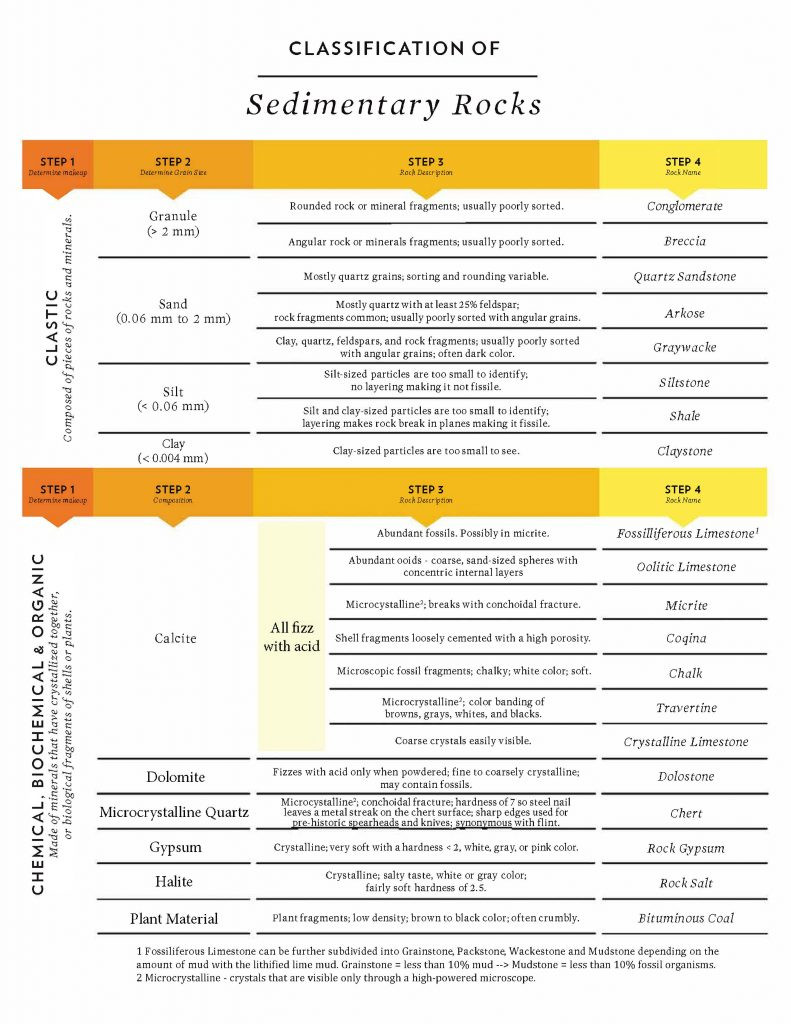 Fossiliferous limestone rock sample
Fossiliferous limestone rock sample -
Oolitic Limestone: Composed of small, spherical grains called ooids.
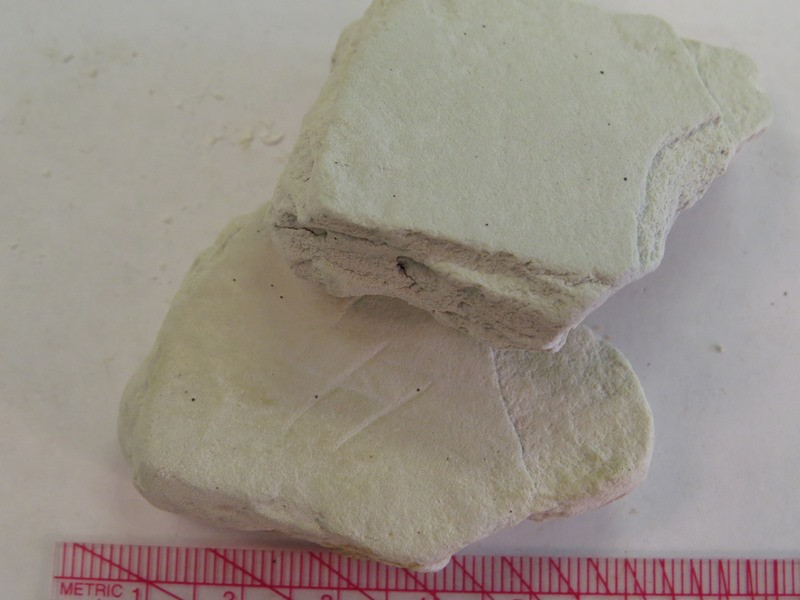 Oolitic limestone rock with spherical grains
Oolitic limestone rock with spherical grains -
Travertine: A form of limestone deposited by mineral springs, especially hot springs.
Figure (PageIndex{1}): Speleothem by Marissa Dudek on Sketchfab -
Chalk: A soft, white limestone formed from the accumulation of microscopic marine organisms called coccolithophores.
-
-
Dolostone: Similar to limestone but contains a high percentage of the mineral dolomite ((CaMg(CO_3)_2)). Dolostone is typically formed when magnesium replaces some of the calcium in limestone.
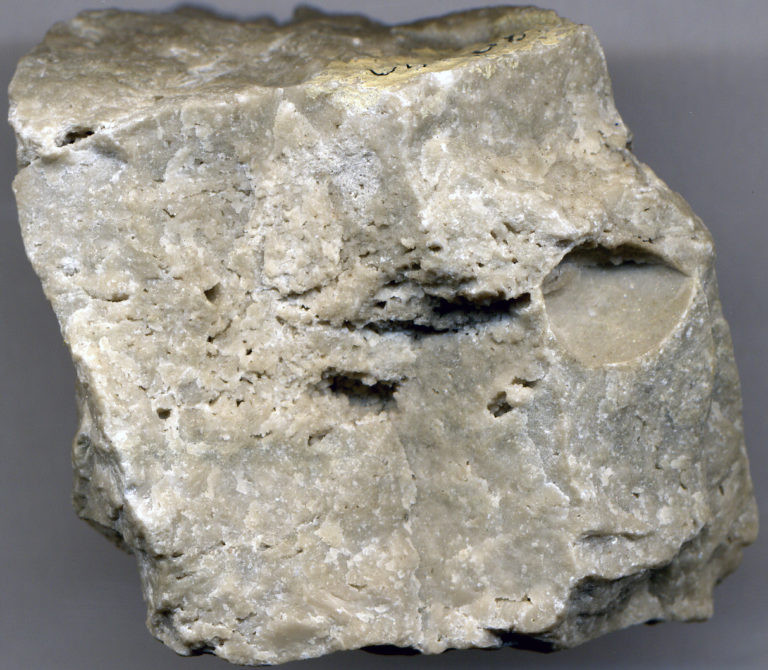 Dolostone rock sample displaying its characteristic texture and composition
Dolostone rock sample displaying its characteristic texture and composition -
Chert: Composed of microcrystalline quartz ((SiO_2)). It often forms from the accumulation of silica-rich organisms’ remains, such as diatoms and radiolarians. Varieties of chert include flint, jasper, and agate.
 Chert rock sample displaying a smooth, glassy texture
Chert rock sample displaying a smooth, glassy texture -
Evaporites: Formed by the evaporation of saline water, leading to the precipitation of minerals such as halite (rock salt) and gypsum. Evaporites are commonly found in arid and semi-arid regions.
-
Rock Salt: Composed of halite (sodium chloride, (NaCl)).
-
Rock Gypsum: Composed of gypsum ((CaSO_4 cdot 2H_2O)).
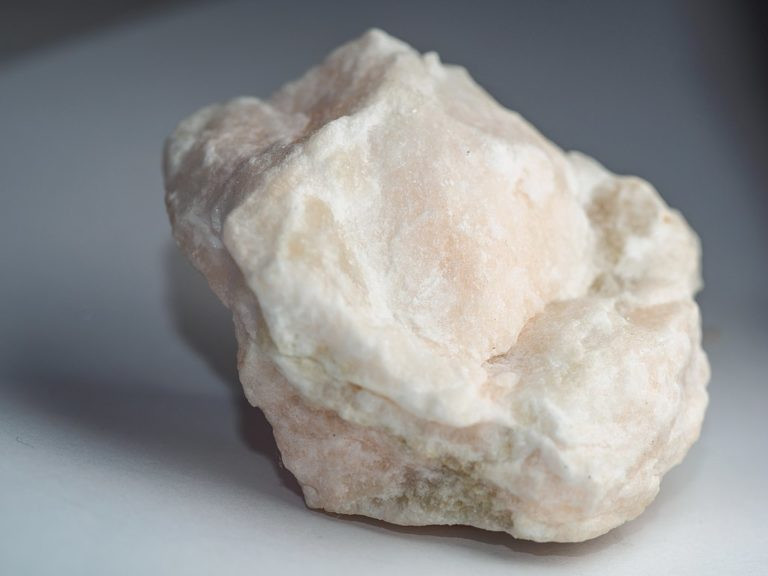 Gypsum rock exhibiting a crystalline structure and light coloration
Gypsum rock exhibiting a crystalline structure and light coloration
-
Characteristics of Chemical Sedimentary Rocks
- Crystalline Texture: Many chemical sedimentary rocks have a crystalline texture, reflecting the precipitation of minerals from solution.
- Chemical Composition: The composition of chemical sedimentary rocks reflects the chemical conditions of the environment in which they formed.
- Stratification: Chemical sedimentary rocks often exhibit distinct layers or beds, reflecting changes in the chemical conditions over time.
Chemical sedimentary rocks provide valuable information about past climates, ocean chemistry, and biological activity. They are also economically important, serving as sources of salt, gypsum, and other minerals.
5. Organic Sedimentary Rocks: The Role of Living Organisms
Organic sedimentary rocks are formed from the accumulation and lithification of organic matter, such as plant and animal remains. These rocks provide insights into past life and environmental conditions, highlighting the significant role of living organisms in sedimentary processes.
Formation of Organic Sedimentary Rocks
The formation of organic sedimentary rocks involves the following steps:
- Production: Living organisms produce organic matter through photosynthesis and other biological processes.
- Accumulation: The organic matter accumulates in environments such as swamps, bogs, and marine basins.
- Preservation: The organic matter is preserved from decay through rapid burial and anaerobic conditions.
- Lithification: The organic matter is compacted and transformed into solid rock through processes like coalification and diagenesis.
Types of Organic Sedimentary Rocks
-
Coal: Formed from the accumulation and compaction of plant material in swamps and bogs. The process of coal formation involves several stages, including the formation of peat, lignite, bituminous coal, and anthracite.
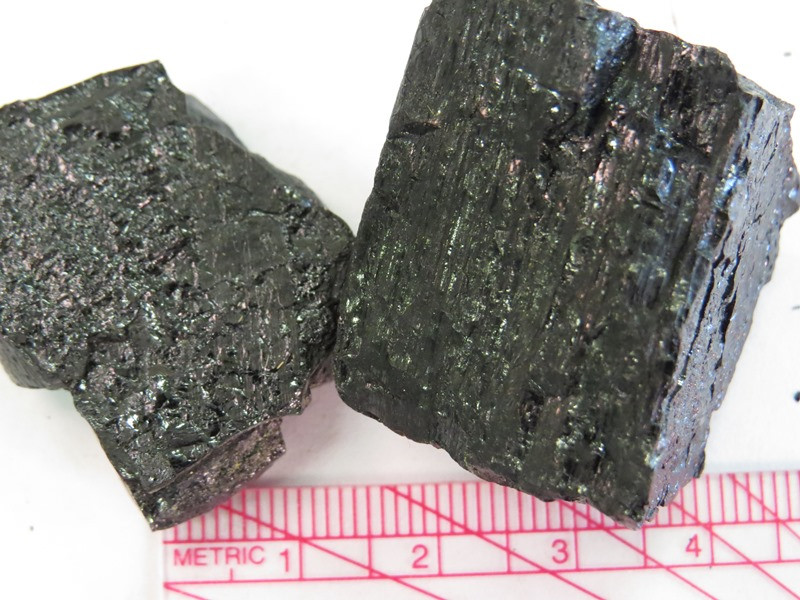 Bituminous coal showing a dark, layered appearance
Bituminous coal showing a dark, layered appearance -
Oil Shale: A fine-grained sedimentary rock containing organic matter called kerogen. When heated, kerogen can be converted into oil. Oil shale is a potential source of petroleum.
-
Fossiliferous Limestone: While primarily a chemical sedimentary rock, fossiliferous limestone contains a significant amount of organic material in the form of fossils. These fossils provide valuable information about past life and environments.
Characteristics of Organic Sedimentary Rocks
- Organic Content: Organic sedimentary rocks are characterized by their high organic matter content.
- Dark Color: Many organic sedimentary rocks are dark in color due to the presence of organic carbon.
- Fossil Content: Organic sedimentary rocks often contain fossils, providing evidence of past life.
- Combustibility: Coal and oil shale are combustible, making them important energy resources.
Organic sedimentary rocks play a crucial role in the global carbon cycle, storing large amounts of carbon in the Earth’s crust. They are also economically important, serving as sources of coal, oil, and natural gas.
6. Sedimentary Rock Textures: Grain Size, Sorting, and Rounding
The texture of a sedimentary rock refers to the physical characteristics of its constituent particles, including grain size, sorting, and rounding. These textural features provide valuable information about the rock’s origin, transport history, and depositional environment.
Grain Size
Grain size refers to the diameter of the individual particles or clasts that make up a sedimentary rock. Grain size is a primary factor in classifying clastic sedimentary rocks.
- Gravel: Clasts larger than 2 mm in diameter. Rocks composed of gravel-sized clasts are called conglomerates (rounded clasts) or breccias (angular clasts).
- Sand: Clasts ranging from 1/16 mm to 2 mm in diameter. Rocks composed of sand-sized clasts are called sandstones.
- Silt: Clasts ranging from 1/256 mm to 1/16 mm in diameter. Rocks composed of silt-sized clasts are called siltstones.
- Clay: Clasts smaller than 1/256 mm in diameter. Rocks composed of clay-sized clasts are called shales or mudstones.
Sorting
Sorting refers to the uniformity of grain sizes in a sedimentary rock.
- Well-Sorted: A rock in which the grains are all about the same size. Well-sorted sediments typically have undergone extensive transport and winnowing, such as beach sands.
- Poorly Sorted: A rock in which the grains vary widely in size. Poorly sorted sediments typically have undergone limited transport and winnowing, such as glacial till.
Rounding
Rounding describes the shape of the edges and corners of the clasts in a sedimentary rock.
- Rounded: Clasts with smooth, curved edges and corners. Rounded clasts indicate extensive abrasion during transport, such as river gravels.
- Angular: Clasts with sharp, jagged edges and corners. Angular clasts indicate minimal abrasion during transport, such as breccias formed near fault zones.
Relationship to Depositional Environment
The texture of a sedimentary rock is closely related to its depositional environment.
- High-Energy Environments: Environments with strong currents or wave action, such as riverbeds and beaches, tend to produce well-sorted, rounded sediments.
- Low-Energy Environments: Environments with weak currents or wave action, such as lake bottoms and deep marine settings, tend to produce poorly sorted, angular sediments.
Understanding the texture of sedimentary rocks is essential for interpreting their origin and history. By examining grain size, sorting, and rounding, geologists can gain insights into the processes that shaped the Earth’s surface in the past.
7. Sedimentary Structures: Clues to Past Environments
Sedimentary structures are features formed during or shortly after the deposition of sediments. These structures provide valuable clues about the depositional environment and the processes that were active at the time of formation.
Types of Sedimentary Structures
- Bedding: The most fundamental sedimentary structure, referring to the layering of sedimentary rocks. Bedding can be horizontal, inclined, or curved, depending on the depositional environment.
- Cross-Bedding: Inclined layers within a bed, formed by the migration of ripples or dunes. Cross-bedding is common in sandstones and indicates deposition in a current of wind or water.
- Ripple Marks: Small, wave-like ridges formed on the surface of a sediment layer by the action of wind or water. Ripple marks can be symmetrical (formed by oscillating currents) or asymmetrical (formed by unidirectional currents).
- Mud Cracks: Polygonal cracks formed in clay-rich sediments as they dry out. Mud cracks indicate alternating wet and dry conditions.
- Fossils: The remains or traces of ancient organisms preserved in sedimentary rocks. Fossils provide valuable information about past life and environments.
- Graded Bedding: A type of bedding in which the grain size decreases from bottom to top. Graded bedding is often formed by turbidity currents, which are underwater flows of sediment-laden water.
Interpretation of Sedimentary Structures
Sedimentary structures can be used to interpret the depositional environment in which a sedimentary rock was formed.
- Beaches: Characterized by well-sorted sand, symmetrical ripple marks, and cross-bedding.
- Rivers: Characterized by gravel and sand, asymmetrical ripple marks, and cross-bedding.
- Lakes: Characterized by fine-grained sediments, mud cracks, and fossils of aquatic organisms.
- Deserts: Characterized by well-sorted sand, large-scale cross-bedding, and wind-blown ripple marks.
- Deep Marine Environments: Characterized by fine-grained sediments, graded bedding, and fossils of marine organisms.
Applications of Sedimentary Structures
Sedimentary structures are not only valuable for interpreting past environments but also for understanding modern sedimentary processes. They can be used to:
- Determine the direction of ancient currents.
- Identify areas of erosion and deposition.
- Locate potential reservoirs for groundwater and petroleum.
- Reconstruct the geological history of a region.
By studying sedimentary structures, geologists can gain a deeper understanding of the Earth’s dynamic surface and the processes that shape our planet.
8. Classifying Sedimentary Rocks: A Step-by-Step Guide
Classifying sedimentary rocks involves a systematic approach that combines field observations with laboratory analysis. This comprehensive method ensures accurate identification and provides valuable insights into the rock’s origin and history.
Step 1: Preliminary Examination
-
Location: Note the geographic location where the rock was found. This can provide clues about the rock’s origin and the geological history of the area.
-
Color: Observe the color of the rock, which can indicate its mineral composition and the presence of certain elements. For example, red rocks often contain iron oxides.
-
Texture: Examine the texture of the rock, including grain size, sorting, and rounding. Use a hand lens or microscope for detailed observation.
Step 2: Determine the Rock Type
-
Clastic: If the rock is composed of visible grains or clasts, it is likely a clastic sedimentary rock. Identify the size and composition of the clasts.
-
Chemical: If the rock is crystalline or composed of interlocking crystals, it is likely a chemical sedimentary rock. Look for evidence of precipitation, such as banding or layering.
-
Organic: If the rock is dark in color and contains visible organic matter, such as plant fragments or fossils, it is likely an organic sedimentary rock.
Step 3: Identify Specific Rock Characteristics
-
Clastic Rocks:
- Grain Size: Determine the dominant grain size (gravel, sand, silt, or clay).
- Sorting: Assess the sorting (well-sorted or poorly sorted).
- Rounding: Evaluate the rounding of the clasts (rounded or angular).
- Composition: Identify the minerals and rock fragments that make up the clasts.
-
Chemical Rocks:
- Mineral Composition: Determine the dominant mineral composition (calcite, dolomite, halite, gypsum, or quartz).
- Texture: Examine the texture (crystalline, granular, or massive).
- Fossils: Look for the presence of fossils.
-
Organic Rocks:
- Organic Content: Estimate the percentage of organic matter in the rock.
- Plant Fragments: Look for recognizable plant fragments.
- Fossils: Identify any fossils present.
Step 4: Laboratory Analysis (If Necessary)
- Microscopy: Use a petrographic microscope to examine the rock’s mineral composition and texture in detail.
- X-Ray Diffraction (XRD): Determine the mineral composition of the rock by analyzing its diffraction pattern.
- Chemical Analysis: Measure the elemental composition of the rock using techniques such as X-ray fluorescence (XRF) or inductively coupled plasma mass spectrometry (ICP-MS).
Step 5: Rock Identification
-
Clastic Rocks:
- Conglomerate: Rounded gravel-sized clasts
- Breccia: Angular gravel-sized clasts
- Sandstone: Sand-sized grains
- Shale: Clay-sized particles
-
Chemical Rocks:
- Limestone: Primarily calcite
- Dolostone: Primarily dolomite
- Rock Salt: Primarily halite
- Chert: Microcrystalline quartz
-
Organic Rocks:
- Coal: Compacted plant matter
- Oil Shale: Contains kerogen
- Fossiliferous Limestone: Limestone with abundant fossils
Step 6: Documentation
- Record all observations and analyses in a detailed report.
- Include photographs or sketches of the rock.
- Reference any sources used for identification.
By following these steps, you can accurately classify sedimentary rocks and gain valuable insights into their origin and history. This process is essential for geologists, environmental scientists, and anyone interested in understanding the Earth’s dynamic surface.
9. Applications of Sedimentary Rock Classification
The classification of sedimentary rocks is fundamental to various fields, providing critical insights into Earth’s history, resource exploration, and environmental management. The insights gained from classifying sedimentary rocks extend beyond academic interest, influencing practical applications across various sectors.
Geological Studies
- Paleoenvironmental Reconstruction: Sedimentary rocks provide valuable information about past environments, climates, and ecosystems. By classifying sedimentary rocks and analyzing their features, geologists can reconstruct ancient landscapes and understand how they have changed over time.
- Stratigraphy: Sedimentary rocks are used to define and correlate rock layers, helping geologists to establish the relative ages of different rock units and understand the geological history of a region.
- Basin Analysis: Sedimentary rocks are studied to understand the formation and evolution of sedimentary basins, which are depressions in the Earth’s crust where sediments accumulate.
Resource Exploration
- Petroleum Geology: Sedimentary rocks are the primary source rocks, reservoir rocks, and cap rocks for petroleum deposits. Classifying sedimentary rocks helps geologists to identify potential oil and gas reservoirs and to understand the processes that control their formation and distribution.
- Mineral Exploration: Sedimentary rocks can host a variety of mineral deposits, including iron ore, uranium, and phosphate. Classifying sedimentary rocks helps geologists to identify areas with high mineral potential.
- Groundwater Resources: Sedimentary rocks are important aquifers, providing a source of fresh water for human consumption and agriculture. Classifying sedimentary rocks helps hydrologists to understand the properties of aquifers and to manage groundwater resources sustainably.
Environmental Management
- Soil Science: Sedimentary rocks are the parent material for many soils. Classifying sedimentary rocks helps soil scientists to understand the properties of soils and to manage them for agriculture, forestry, and other land uses.
- Geomorphology: Sedimentary rocks influence the shape of the Earth’s surface through weathering and erosion. Classifying sedimentary rocks helps geomorphologists to understand the processes that shape landscapes and to predict how they will respond to future changes.
- Environmental Remediation: Sedimentary rocks can be contaminated by pollutants from industrial activities or waste disposal. Classifying sedimentary rocks helps environmental scientists to assess the extent of contamination and to develop strategies for remediation.
Construction and Landscaping
- Building Materials: Sedimentary rocks such as limestone, sandstone, and shale are used as building materials for houses, roads, and other structures. Classifying sedimentary rocks helps engineers to select appropriate materials for different applications.
- Landscaping: Sedimentary rocks are used in landscaping to create aesthetic features such as walls, patios, and rock gardens. Classifying sedimentary rocks helps landscapers to select rocks with the desired color, texture, and durability. Rockscapes.net is an excellent resource for landscapers looking for the perfect sedimentary rocks to enhance their designs.
10. The Importance of Sedimentary Rocks in Landscaping
Sedimentary rocks are indispensable in landscaping, offering a wide array of textures, colors, and shapes that can enhance the beauty and functionality of outdoor spaces. Rockscapes.net provides a diverse selection of sedimentary rocks, making it an ideal resource for homeowners, landscapers, and designers looking to incorporate natural elements into their projects.
Aesthetic Appeal
Sedimentary rocks add a natural and timeless beauty to landscapes. Their varied colors and textures can complement any design style, from rustic to contemporary. For example, the warm tones of sandstone can create a cozy, inviting atmosphere, while the cool grays of slate can add a touch of sophistication.
Versatility
Sedimentary rocks can be used in a variety of landscaping applications:
- Walls: Sedimentary rocks can be used to build retaining walls, garden walls, and decorative walls. These walls not only add visual interest but also provide structural support.
- Patios and Walkways: Sedimentary rocks such as flagstone and pavers can be used to create patios, walkways, and stepping stones. These materials are durable and slip-resistant, making them ideal for outdoor use.
- Rock Gardens: Sedimentary rocks are essential for creating rock gardens, which are designed to showcase the beauty of rocks and plants. Rock gardens can be used to add texture, color, and dimension to landscapes.
- Water Features: Sedimentary rocks can be used to create water features such as waterfalls, ponds, and streams. These features add a soothing and tranquil element to landscapes.
- Edging and Borders: Sedimentary rocks can be used to create edging and borders around gardens, flower beds, and lawns. These features help to define spaces and add a finished look to landscapes.
Durability and Sustainability
Sedimentary rocks are durable and long-lasting, making them a sustainable choice for landscaping projects. They can withstand harsh weather conditions and require minimal maintenance. Additionally, using locally sourced sedimentary rocks can reduce transportation costs and environmental impact.
Environmental Benefits
Sedimentary rocks can provide environmental benefits in landscaping:
- Erosion Control: Sedimentary rocks can be used to stabilize slopes and prevent erosion.
- Water Conservation: Sedimentary rocks can be used as mulch to retain moisture in the soil.
- Habitat Creation: Sedimentary rocks can provide habitat for beneficial insects and wildlife.
Choosing the Right Sedimentary Rocks
When selecting sedimentary rocks for landscaping, it is important to consider the following factors:
- Color and Texture: Choose rocks that complement your design style and the surrounding environment.
- Size and Shape: Select rocks that are appropriate for the intended use.
- Durability: Choose rocks that are resistant to weathering and erosion.
- Cost: Consider the cost of the rocks and the installation.
Rockscapes.net offers a wide variety of sedimentary rocks to meet your landscaping needs. Our experts can help you choose the right rocks for your project and provide guidance on installation and maintenance.
Ready to transform your landscape with the natural beauty of sedimentary rocks? Visit Rockscapes.net today to explore our extensive collection and get expert advice from our team. Whether you’re designing a tranquil rock garden, a sturdy retaining wall, or a charming stone pathway, we have the perfect sedimentary rocks to bring your vision to life. Contact us at Address: 1151 S Forest Ave, Tempe, AZ 85281, United States, Phone: +1 (480) 965-9011, or visit our website at Rockscapes.net and let us help you create an outdoor space that is both beautiful and sustainable.
11. FAQ: Understanding Sedimentary Rock Classification
What is the primary basis for classifying sedimentary rocks?
Sedimentary rocks are primarily classified based on their origin and composition, which includes clastic (fragments of other rocks), chemical (precipitation of minerals), and organic (accumulation of organic matter).
How do you distinguish between conglomerate and breccia?
Conglomerates are composed of rounded gravel-sized clasts, indicating significant transportation and abrasion, while breccias contain angular clasts, suggesting minimal transportation.
What is the main component of limestone, and how does it form?
Limestone is mainly composed of calcium carbonate (CaCO3) and forms through inorganic precipitation or the accumulation of marine organisms’ shells and skeletons.
What conditions are necessary for the formation of evaporites like rock salt and gypsum?
Evaporites form in arid conditions where saline water evaporates, leading to the precipitation of minerals such as halite (rock salt) and gypsum.
How is coal formed, and what type of sedimentary rock is it?
Coal is an organic sedimentary rock formed from the accumulation and compaction of plant material in swamps and bogs, undergoing coalification over time.
What does the texture of a sedimentary rock reveal about its origin?
The texture, including grain size, sorting, and rounding, provides valuable information about the rock’s transport history, depositional environment, and the energy conditions present during its formation.
What are sedimentary structures, and why are they important?
Sedimentary structures like bedding, ripple marks, and mud cracks are features formed during or shortly after deposition, providing clues about the depositional environment and processes active at the time of formation.
How are sedimentary rocks used in paleoenvironmental reconstruction?
Sedimentary rocks provide valuable information about past environments, climates, and ecosystems, allowing geologists to reconstruct ancient landscapes and understand how they have changed over time.
What role do sedimentary rocks play in petroleum geology?
Sedimentary rocks serve as source rocks, reservoir rocks, and cap rocks for petroleum deposits, making their classification crucial for identifying potential oil and gas reserves.
How can sedimentary rocks be used in landscaping, and what benefits do they offer?
Sedimentary rocks add aesthetic appeal, versatility, durability, and environmental benefits to landscapes, serving as materials for walls, patios, rock gardens, and water features, and promoting erosion control and water conservation. rockscapes.net offers a wide variety of sedimentary rocks for your landscaping needs.
